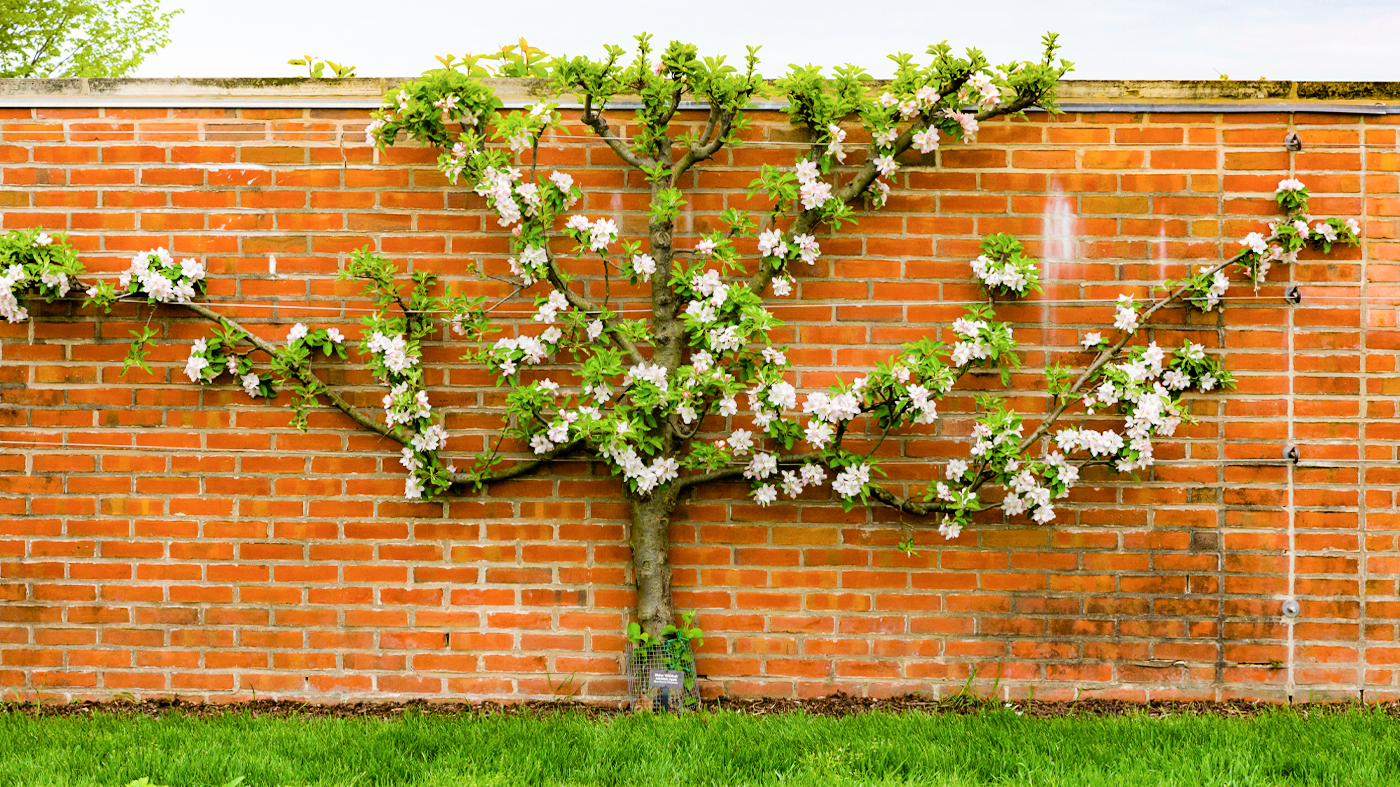

Tips & Techniques
Espalier an Apple Tree
Espalier is a method of training and pruning a tree or shrub, forcing it to grow flat against a wall or a free-standing trellis. Although it originated in the Middle Ages as a way to grow fruit inside the safety of castle walls, many nonfruiting plants, including yews, cotoneaster, magnolias, and dogwood can be espaliered.

Beautiful Yet Practical
Espalier has a great deal of ornamental value — few garden scenes are more stunning than a blooming apple tree growing against a brick wall — but it's also an effective technique for producing an ample crop of fruit in a small space. You don't need an orchard to grow apple trees. A sunny wall, a special pruning technique, and patience are all you need to espalier an apple tree.
To encourage substantial fruit production, prune with two objectives in mind. First, train the tree to the classic flattened, horizontal shape of espalier. Second, encourage the growth of short fruiting stems, or spurs, that will ultimately produce apples.
Mail-order catalogs are often the best source for selecting trees to espalier. Popular varieties hardy to the Chicago area include 'Northern Spy', 'Golden Delicious', 'Liberty', 'Redcourt', and 'Holiday'. Others that have shown extreme hardiness and good disease resistance include 'Honeycrisp', 'Sweet Sixteen', and 'State Fair'. Some varieties, such as 'Golden Delicious', are self-fertile, meaning they do not need another apple variety with which to pollinate. Others, however, will require a nearby different apple variety to complete pollination and produce fruit.
Start with a tree that has been grafted onto dwarf rootstock. All commercial apple trees are grafted onto roots from selected hardy apple trees. Some rootstock is dwarfing and will produce small trees; other rootstock produces full-size trees. If you espalier a full-size tree, it will have much thicker, heavier trunks and branches. Catalogs will indicate the type of rootstock used. Two desirable rootstocks to look for are the semi-dwarf M27 or the mini-dwarf MAL27.
You will begin with a 2- to 3-foot sapling, or whip, that is still very pliable and has not yet grown any side branches. It can be planted against a wall, a sturdy trellis or other flat surface. The wall will have an added advantage of absorbing heat to hasten ripening.
Create an Apple-bearing Espalier
- String three to four rows of galvanized wire horizontally on the wall or trellis, about 2 feet apart.
- Plant the 3-foot whip in the middle of the structure. Find the lowest bud on the whip and prune off the wood above it. That bud should be about 2 feet from the base of the whip and coincide with the lowest wire.
- Lateral branches will begin to grow out and away from the cut. Tie one end of a bamboo cane to the first horizontal wire and the other end to the young branch, pulling it down toward the wire and training it to grow along the wire. It usually takes two growing seasons to get branches to grow at right angles to the main vertical trunk.
- In the meantime, the whip will continue to grow upward from the original bud you located when you made the first cut. Let it grow to the second horizontal wire and again make a cut above a bud. When lateral branches grow from that point, repeat the process of attaching them to the horizontal wires.
- A typical espalier is 6 to 8 feet tall, with three to four sets of horizontal branches. Your goal is to keep the tree in bounds. Fruit yields will be proportionately much greater from an espalier than from a full-size tree.
Patience Required
It generally takes five to seven years to create a completed espalier structure and harvest fruit. Until that time, prune out any developing fruit. Your goal in the first few years is to encourage the tree to put all of its energy into growing branches that establish the basic framework. Once that happens, all future pruning is to encourage fruit production. Apples on all trees, whether espalier or not, are borne on short stems called spurs. As buds and new shoots form along a lateral branch, prune them back to a point close to the branch where five leaves cluster around the stem. This encourages the buds on the bottom half of the lateral branch to produce fruit. This pruning will also remove the end buds that are more likely to produce leaves and stems.
Before attempting espalier, visit the Chicago Botanic Garden's Regenstein Fruit & Vegetable Garden to study the many examples of mature fruit espaliers trained against brick walls and free-standing trellises. There is also a display of nonespalier apple trees planted in a large semicircle, with dwarf species in front and the full-sized trees in back. The dwarf trees are examples of the type of apple tree you could use to make a perfect espalier in your sunny yard.

